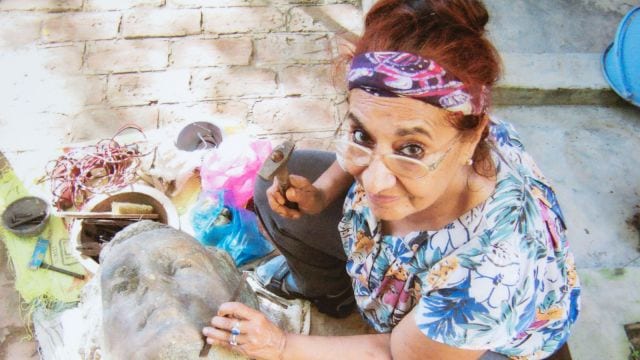📣 For more lifestyle news, click here to join our WhatsApp Channel and also follow us on Instagram
Latika Katt, one of India’s most prolific sculptors, passes away at 76
From larger-than-life statues of political leaders to capturing the intricacies of nature, Latika Katt experimented in multiple mediums, from cow dung and terracotta to stone and bronze.
 Katt is one of India’s most prolific sculptors who worked in multiple media for over five decades. (Photo: DAG)
Katt is one of India’s most prolific sculptors who worked in multiple media for over five decades. (Photo: DAG)While she intently studied dead bodies – their skin and bones – for her portraits in clay and bronze, sculptor Latika Katt also found immense joy in understanding the teamwork of termites and bees. A winner of numerous national and international awards, Katt is known for her larger-than-life sculptures and busts of public figures and for her ability to capture the essence of nature in its organic forms.
Katt is one of India’s most prolific sculptors who worked in multiple media for over five decades, using everything from terracotta and papier-mâché to stone and bronze. She passed away on Saturday night in Jaipur. She was 76.
Before making public sculptures, Katt was intentional in her site visits, investigating wind directions and mapping perspectives, sometimes even 16-feet below ground. It’s evident in the 20-ft bronze sculpture of Jawaharlal Nehru at the Jawahar Bhawan in Delhi, where she depicted him releasing pigeons into the skies.
Being a sculptor was her calling. She felt it the moment the rough texture of a tree bark passed through her hands in her second year of fine arts at Banaras Hindu University. Painting was too simple and didn’t require any engagement unlike clay and wood which one had to physically interact with. To poke, scrap, knead and chip the medium in hand meant the body became part of the act of making.
 Katt was known for her ability to capture the essence of nature in its organic forms. (Photos: DAG)
Katt was known for her ability to capture the essence of nature in its organic forms. (Photos: DAG)
Her master’s at MS University, Baroda, and a research scholarship from the Slade School of Art, London, gave her the needed impetus as a sculptor. From the cow dung on Varanasi ghats to the tree trunks at MSU, Katt was willing to experiment with all kinds of mediums. Her then teacher and late husband Balbir Singh Katt would be instrumental in this exploration of materials.
While her bronze sculpture ‘Makarsankranti Nahan at Dashaswamedh Ghat’ (for which she won the Beijing Art Biennale Award in 2010) shows figures in the everydayness of life, the bronze fruit on the ‘Banana Tree’ curves up like thick fingers clinging together. Her Rodin-esque faces of well-known people, including artists such as Ramkinkar Baij and Somnath Hore, author Mulk Raj Anand and leaders like Mahatma Gandhi and Nehru, have stories of their own.
In a public lecture at the Lalit Kala Akademi Chandigarh in 2013 she shared how Baij, the father of modern sculpture in India, was initially unsure if this 45-kg petite girl could manage making his portrait. But over Rabindra Sangeet and drinks, he was finally happy when he saw the layered, rugged treatment she gave his face.
Conceptual artist and photographer Diwan Manna and former president of the Punjab Lalit Kala Akademi, says “She always met challenges head-on. Being a sculptor is hard work, you need the stamina and vigour, your hands can get burnt or your fingers grazed, you need to work in the different geographies and climate, often out in the open, and Latika was always ready for it. She was a fighter, who stood up against anything she found unpalatable. I was, perhaps, one of the few people whom she has never had a fight with! Art is emotion and she worked intensely with her hands. There is a certain bond you have with the medium itself, the pressure of the hammer, the change of a contour and each emotion plays out on the final product. And in Latika’s work you can see that kinetic energy.”
📣 For more lifestyle news, click here to join our WhatsApp Channel and also follow us on Instagram






- 01
- 02
- 03
- 04
- 05





















